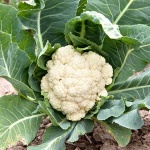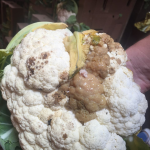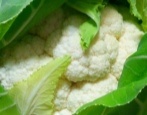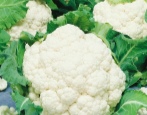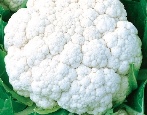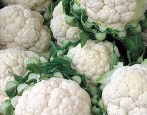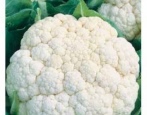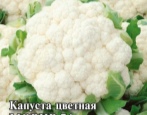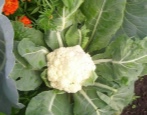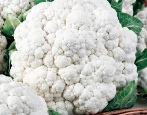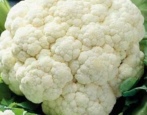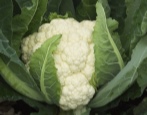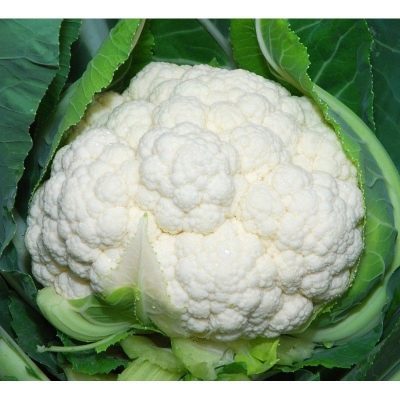
- Appointment: for home cooking, for freezing, for canning, for fresh consumption
- Leaf color: bluish green
- Yield: high
- Average yield: 3 kg / sq.m
- The form: domed
- Coloration: white
- Weight, kg: 0,7-0,8
- Taste qualities: high
- Growing conditions: for open ground
- The size: very large
Many gardeners believe that growing cauliflower is very difficult and requires some care. But the Snow Globe cauliflower is ideal for the first cultivation, as it has good yields, easy and simple maintenance, as well as taste and methods of processing heads.
Description of the variety
Cabbage is suitable for outdoor cultivation, and also has a universal purpose.
Among the positive aspects, the small size of the bushes is most often noted. Summer residents say that the culture is non-conflict, and if you plant seedlings very close to each other, they will have enough room for normal development.
The variety can quickly adapt to changing climatic conditions. Therefore, with a slight decrease in temperature, the bushes can not be covered with agrofibre. It is also not necessary to build a film greenhouse for growing cabbage.
Cauliflower Snow Globe is not a hybrid, so small, quality seeds can be found in the fruit.
The plant has good immunity to common diseases. They will not develop, provided that the irrigation regime is correctly followed and the place for the germination of the crop is chosen.
Of the minuses, there are 2 points. The first is the small size of the cabbage heads. The second is a short shelf life, only 2 to 4 months.
Characterization of the appearance of the plant and heads
As mentioned earlier, the Snow Globe cabbage has a compact bush. The rosette begins with the formation of large bluish green leaves with carved edges. As soon as the head begins to ripen, the leaves gradually begin to shrink towards the center. This does not allow the head to form large.
The productive part has shoots and inflorescences. They are tightly adjacent to each other. Seeds are stored in these inflorescences. It is worth paying special attention to the inflorescences. If the buds begin to open intensively, then this is a sign that in the future the vegetable will be unsuitable for human consumption.
At the beginning of technical ripeness, a dome-shaped, slightly flattened large head is formed in cabbage. Its average weight is 0.7-0.8 kg. It is white and dense in color.
Purpose and taste
Cabbage has a universal purpose, therefore, the head is most often used in home cooking (cooking soups, salads, hot dishes, mashed potatoes). The culture can be frozen, canned, fermented.
The taste of the variety is excellent. Many summer residents note a pleasant and juicy taste. And also cabbage can be consumed by allergy sufferers and used for dietary nutrition.
Ripening terms
The Snezhnyi glob variety belongs to mid-season crops. The growing season takes 115 to 120 days. Harvesting falls in August-September.
Yield
Summer residents note that cabbage has a high yield. From 1 m2 on average, you can collect up to 3 kg.
Growing regions
There are no restrictions on the growing regions of cabbage. She shows herself well in the Central and Ural regions, in the northern latitudes, as well as in the south.
Growing and care
Cauliflower, like ordinary cabbage, is grown in seedlings. Seedlings can be purchased on the market or prepared on their own.
The first thing to do is to prepare the ground. You can buy it or prepare it yourself. When self-harvesting, it is necessary to add peat and sand in equal proportions to the soil.And then, after mixing the mixture in a container, sprinkle it on a baking sheet and bake it in the oven at 80 ° C. It is not recommended to set high temperatures, because the soil can become barren.
If the seeds are coated with glaze, then they should be soaked briefly in water and then sown. But if the seeds are harvested by hand, then they must first be processed. To do this, you can choose a weak solution of potassium permanganate. You need to dip the seeds in the solution for 10 minutes, and then rinse with water.
Some summer residents also recommend immersing the seeds first in heated water (about 50 ° C), and then in cold water. Then dry everything. This will help get rid of a disease such as keela, while the bushes will develop amicably and actively.
If you sow seeds in one large seedling box, then after a while the seedlings will need to dive. But if you plant seeds in separate small peat pots, then picking will not be necessary. But this is done at the discretion of each gardener.
For good germination, seedlings must provide the following:
light lamp;
correct watering;
picking (if necessary);
top dressing;
loosening.
In late April - early May, seedlings can be taken outside for acclimatization. The holes must be prepared in advance, according to the scheme 30x50 cm with a depth of 15 cm.
Follow-up care will include:
watering (up to 10 liters per 1 m2);
top dressing (3-4 times per season);
loosening of the soil and hilling;
preventive work to combat diseases and pests.
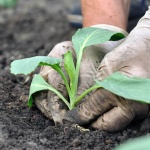
Soil requirements
Cabbage does not tolerate acidic soils, so the soil should be loose, slightly acidic or neutral.
